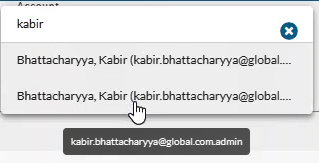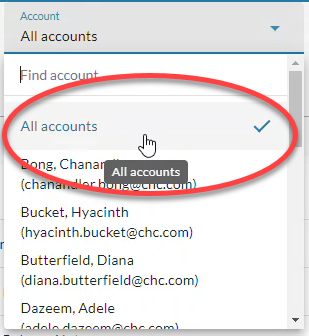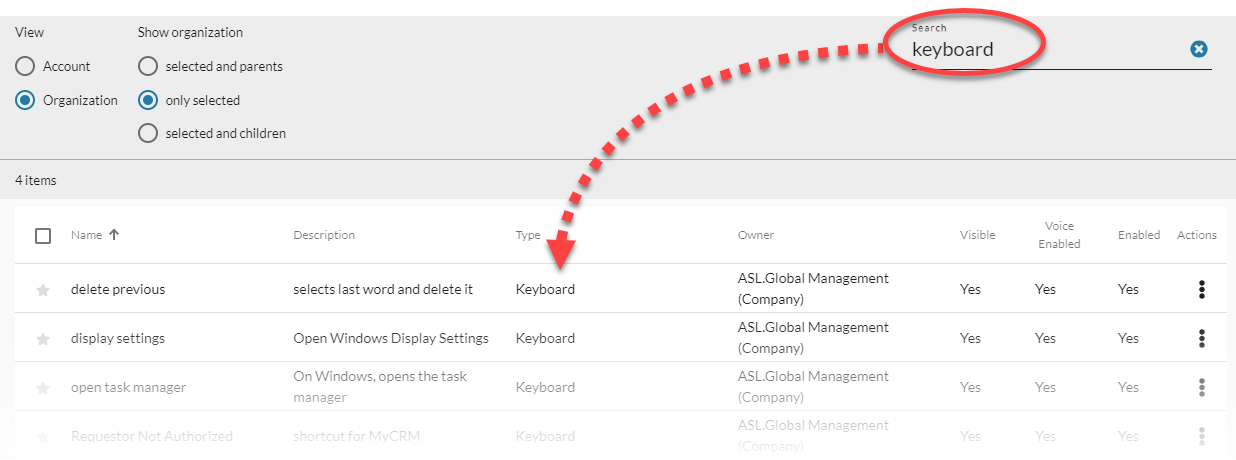On the shortcuts page in nVoq Administrator you can create, update, and delete shortcuts and shortcut folders.
Shortcuts Page Toolbar

Change Enabled 
When one or more shortcuts that belong to the organization level selected in the organization menu at the top of the page (or to a higher organization level) is selected using the checkmark to the left of the Name column, the Change Enabled icon will appear in the toolbar as long as the logged-in user has the ability to make changes to shortcuts for the selected organization.
- Selecting the Change Enabled icon in the toolbar will change the enabled status (in the Enabled column) of the selected shortcuts from Yes (enabled) to No (disabled) or vice versa for the selected organization. The status in the Enabled column changes immediately.
- Shortcuts enabled or disabled at higher organization levels will set that enabled status for all child organizations below it.
Delete 
When one or more shortcuts and or folders is selected using the checkmark to the left of the list, the trash can icon will appear in the toolbar IF the logged in user has the ability to make changes to the shortcut. Click the trash can icon to delete the selected shortcuts and/or folders. Administrators with read only access will only be able to delete shortcuts or folders from their own account.
Copy 
Copy shortcuts from an account or organization to another account or organization.
Administrators with Read-Only access cannot copy shortcuts by selecting them and clicking the copy icon in the blue toolbar. The only way this type of user can copy shortcuts is one-at-a-time by clicking the actions menu and selecting Copy. Shortcuts are copied to the administrator's own personal account shortcuts list.
Upload 
Click on the upload icon to upload a spreadsheet to add multiple shortcuts and folders. This option does not display if "All Accounts" is selected on the Account menu.
Download 
Click on the download icon to download a .csv file that includes all shortcuts and folders in the selected organization or account. Administrators with read only access will only be able to download.
New 
Click on the plus symbol to create a new shortcut or a new folder. The shortcut or folder will be created in the selected account OR at the organization level selected in the Organization menu at the top of the page. Administrators with read only access will only be able to add shortcuts or folders to their own account. This option does not display if "All Accounts" is selected on the Account menu.
Support Center 
Click on the question mark icon in the blue toolbar to go directly to the online documentation for the Shortcuts page. (The black question mark icon at the top right goes to the nVoq Administrator main help page.)
View
Select the radio button for Account or Organization. Use this in conjunction with the organization menu at the top of the page.
Account
Select the Account radio button to view individual user account shortcuts and folders.
- When you select the account radio button the Account menu displays to the right.
- The menu will display a maximum of 250 accounts. If there are more than 250 accounts in the selected organization, the bottom of the menu will say, "Showing 250 out of [#] possible accounts."

- To see shortcuts and folders for an individual user account, type part of the person's name in the the Find Account field. This will find any account that exists in the selected organization, even if it is not displayed in the menu.

- If the username is cut off, hover your mouse over the name to see the username in a tooltip.

- If you want to see all user account shortcuts and folders for all users in the organization selected at the top of the page, select All Accounts.

- The menu will display a maximum of 250 accounts. If there are more than 250 accounts in the selected organization, the bottom of the menu will say, "Showing 250 out of [#] possible accounts."
Organization
Select the Organization radio button to view organization shortcuts and folders.
- When you select this option you see a "Show Organization" menu which allows you to select whether or not you want to view shortcuts and folders for organizations above or below the organization selected in the organization menu at the top of the page. When first going to the page, you will not see ANY items that exist at the organization level unless one of these options is selected.
- Selected and Parents - Display shortcuts and folders created for the organization selected in the organization menu and all parent organizations above it.
- Only Selected - Display shortcuts and folders created for only the organization selected in the organization menu.
- Selected and Children - Display shortcuts and folders created for the organization selected in the organization menu and all child organizations below it.

Search
Use the Search field at the top right of the page to search for text in any of the columns. Enter all or part of a word or name.

Shortcuts Page Columns
Click on any column header on the page to sort information in ascending or descending order.
- Folders appear in alphabetical order at the top of the shortcut list when columns are sorted in ascending order. They appear at the bottom of the list when columns are sorted in descending order.
- Sort order is retained after selecting a different organization in the organization menu. Sorting and scrolling location are remembered when leaving and returning to a page, even if you log out and back in.

Star or Folder Icon / Checkbox
Organization shortcuts are listed with gray star icons on the left side of the list, account shortcuts have white star icons. Organization folders are listed with gray folder icons, account folders have white folder icons.
Hover your mouse over a star icon ![]() /
/ ![]() or folder icon
or folder icon ![]() /
/ ![]() and click to put a checkmark in the box to select the shortcut or folder in order to perform an action on it from the blue toolbar. Once selected, the row turns green and there is a checkmark on the left side.
and click to put a checkmark in the box to select the shortcut or folder in order to perform an action on it from the blue toolbar. Once selected, the row turns green and there is a checkmark on the left side.
- You can select multiple shortcuts and/or folders by clicking on each icon and then perform actions available from the icons in the blue toolbar on all selected shortcuts.
- You can select all shortcuts and folders in the list by putting a checkmark in the box on the left side of the column headers (above the star/folder icons).

Name
The name of the shortcut or folder. You can use the Search field near the top-right (in the gray area) to search for a shortcut or folder by name.
Click the > arrow to the left of a folder name to expand the folder view and see the shortcuts inside. The names of shortcuts inside folders appear indented in the column under the folder name.

Description
This is identifying information about the shortcut or folder, like where the shortcuts work, the relationship of shortcuts inside a folder, a shortcut's status, etc. This field is optional for both shortcuts and folders, so may be blank.
Type
This indicates the kind of shortcut and explains generally what the shortcut does. The options are: Insert (Insert Text), Open Web, Open File, Keyboard (Keyboard Automation), Template (Insert Template), HTML (HTML Automation), or Workflow (Workflow Automation). This information only applies to shortcuts (not folders). Only Insert (Insert Text) shortcuts can be used in nVoq Voice and Mobile Voice.
Owner
This column lists the name of the organization or user account under which the shortcut or folder was created. Organization shortcuts are available (unless disabled) for all client users at and below the organization listed in this column. Organization folders are available for all client users at and below the organization listed in this column; they cannot be disabled.
Visible
A "Yes" in this column indicates the shortcut displays in the shortcut menu in nVoq Voice and nVoq Mobile Voice. A "No" in this column indicates that the shortcut is not visible in any nVoq client. This information only applies to shortcuts (not folders).
Voice Enabled
A "Yes" in this column indicates that the shortcut can be used as a voice shortcut by pressing a hotkey and saying the shortcut name out loud. A "No" in this column indicates that the shortcut cannot be launch with a voice command, and can only be launched as a popup shortcut (as long as it is Visible). This information only applies to shortcuts (not folders).
Enabled
A "Yes" in this column indicates that the shortcut available to use by nVoq Voice or nVoq Mobile Voice users in the selected organization. A "No" in this column indicates that the shortcut is disabled (unavailable) to users. This information only applies to shortcuts (not folders).
Actions
Click on the Actions icon ![]() to open a menu and select an action to take with the shortcut or folder
to open a menu and select an action to take with the shortcut or folder
This menu shows the appropriate actions that users can take depending on the Admin Role and Admin Level of the logged-in user. For example, client only users will see only a View option for organization shortcuts, but for their own account shortcuts they'll have the ability to Edit Shortcut, Duplicate, or Delete. Likewise, a Customer Administrator at a company level will only see the View option for tenant-level shortcuts, but will see the Edit, Duplicate, and Delete options for shortcuts at the company level and below.
Possible actions include:
- Edit Shortcut: Open the shortcut to make changes.
- Edit Folder: Open the folder to make changes.
- Copy: Copy the shortcut from an account or organization to another account or organization.
This is the only way administrators with Read-Only access can copy shortcuts; they are copied to the administrator's own personal account shortcuts list. - Delete: Remove the shortcut or folder. When this option is selected a message will appear letting you know that "Deleting a Shortcut will permanently remove it" (or "Deleting a Folder will permanently remove it") and ask you to confirm that you want to delete the shortcut or folder.
- Change Enabled - Modify the enabled status of the shortcut for the organization selected at the top of the page. To change the status of a shortcut open the Actions menu and select Change Enabled. The status in the Enabled column changes immediately. Shortcuts enabled or disabled at higher organization levels will set that enabled status for all child organizations below it.
Enabling a previously disabled shortcut at a lower organization level will also enable the shortcut in the parent and child organizations above and below it. For example, if a tenant level shortcut was disabled at the company level and then enabled for a division below that company, it is then automatically also enabled for the company, the division, and the groups below that division. - View Shortcut: Opens the shortcut to view details, but the user cannot make changes. This will present for shortcuts that cannot be edited by the logged-in user (for example, an organization shortcut cannot be edited by a client-only user or by an admin user with a Read-Only role).
- View Folder: Open the folder but can not make changes. This will present for folders that cannot be edited by the logged-in user (for example, an organization folder cannot be edited by a client-only user or by an admin user with a Read-Only role).
- Remove Shortcut: This option removes the shortcut from a folder and it displays on the actions menu for shortcuts inside a folder when the folder is expanded on the list view.